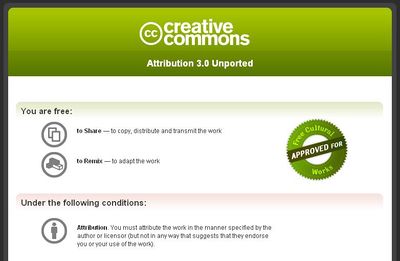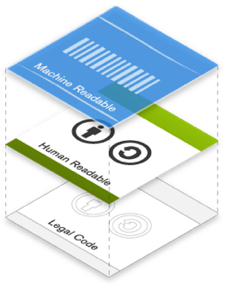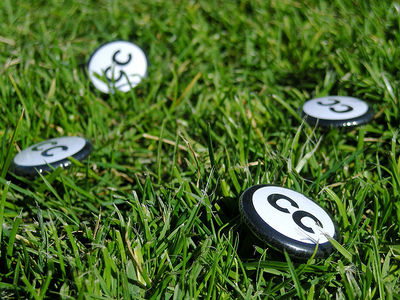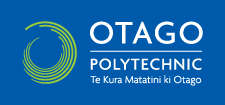Anatomy of a CC license
A CC[1] license is composed of three distinct layers.
- Legal Code - Each license begins as a traditional legal tool, in the kind of language and text formats that most lawyers know and love. This is the actual license, which is a detailed legal document.
- Commons Deed - This is a handy reference that summarizes and expresses some of the most important terms and conditions. Think of the Commons Deed as a user-friendly interface to the Legal Code beneath, although the Deed itself is not a license, and its contents are not part of the Legal Code itself.
- Machine-readable version - The final layer of the license design is a “machine-readable” version of the license - a summary of the key freedoms and obligations written into a format that software systems, search engines, and other kinds of technology can understand.
The Legal Code - valid legal documents
All CC licenses have real legal code, written by and for lawyers, which contains the actual, legally binding terms of the license.At the bottom of a Commons Deed ("human-readable" version), you will find a link to the legal code which is the full license. If you are new to CC licenses, we suggest that you scan through one or two of the full licenses to get an idea of what is covered in the legal code. Here are the links to the full licenses:
- Attribution
- Attribution — Share-Alike
- Attribution — No Derivatives
- Attribution — Non-Commercial
- Attribution — Non-Commercial — Share-Alike
- Attribution — Non-Commercial — No Derivatives
The Commons Deed - a "human-readable" version of the license
Unlike typical licensing terms (and most other available open licenses), CC licenses include a summary deed which conveys the terms of each license using simple, universal icons and non-technical language.

You can preview examples of the license deed for each of the CC licenses:
- Attribution
- Attribution — Share-Alike
- Attribution — No Derivatives
- Attribution — Non-Commercial
- Attribution — Non-Commercial — Share-Alike
- Attribution — Non-Commercial — No Derivatives
Note that many countries have ported the CC licenses to different legal jurisdictions around the world. These ported licenses differ only in that they have been modified to reflect any local nuances in how legal terms and conditions are expressed, drafting protocols and, of course, language. The ported licenses and the international licenses are all intended to be legally effective anywhere. For the purposes of this international course we use the unported licenses which were drafted to be utilized and enforceable around the world without further modification.
"Machine-readable" licenses
The machine-readable feature of the licenses makes finding CC-licensed material on the Internet possible. Machine-readable refers to the fact that the license information about your work includes some software code. This software code allows search engines (e.g., Google, Yahoo, etc.) and other software applications to identify materials on the Internet that are licensed using Creative Commons. So if you license your material under Creative Commons, others will be able to easily find and identify your work.
The machine-readable code can be obtained using the CC license chooser tool. Once a license is identified, the tool automatically generates the HTML syntax which can be copied and embedded into web pages on the Internet. This syntax would not be visible to people browsing your web pages but can be read by search engines and in this sense, CC licenses are "machine-readable". Consult your local technical staff for more information on embedding machine-readable code for CC licenses into a web page.
Acknowledgements
Some content on this page was sourced, revised and remixed from:
- http://creativecommons.org/licenses/
- http://wiki.creativecommons.org/FAQ
- CCLearn explanations, OER and CC licenses
Notes



